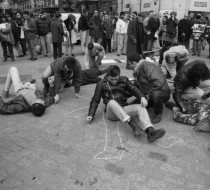The Fight Against AIDS, La Radical Gai in 1994 Favorite
This act of art and activism displayed in the photograph was created in 1994 by the group La Radical Gai at the height of the HIV and AIDS epidemic that decimated many communities in Madrid. The first case of AIDS in Spain was documented in 1982. Since that time, 85,000 people in Spain have been diagnosed with AIDS and 60,000 people have died from the deadly virus (Soriano, Ramos, Barreiro, Fernandez-Montero, 2018). The political activist group of La Radical Gai protested the Spanish Ministry of Heath’s ignorance of the dangers of AIDS that was apparent in the rising death count during 1993 and 1994.
The actions depicted in the above photograph occurred in Puerta De Sol in Madrid, Spain. La Radical Gai and Lesibianas Sin Duda began protesting in Puerta de Sol on December 1st, 1994. Members of the activist organizations created a die-in activist movement by laying on the ground of the plaza and members of the group traced the outline of their body. Later, the activists wrote AIDS within the outline to represent the rising death count of citizens who were dying of AIDS. This act of performance activism represented the dead bodies resulting from AIDS. This performance artwork was an act of political activism against the Spanish government for the false narrative that was created by the Spanish Ministry of Health that HIV and AIDS were only a homosexual issue (“La radical Gai & Lesbianas Sin Duda”, 2021). The false narrative created issues for the LGBTQ community in Madrid which inspired the activism depicted in this photograph (“La radical Gai & Lesbianas Sin Duda”, 2021).
La Radical Gai was one of the first queer movements to come out of Spain. La Radical Gai was founded in 1991. La Radical Gai followed a queer political thinking model, today known as queer theory which “subverts traditional institutions of society that are based on the heteronormative model of human sexuality, and acknowledges the broad spectrum of sexuality, sexual orientation, and gender identity” (Leonard, 2021). This model of thinking was an integral part of La Radical Gai’s actions as the outline of the body did not represent a single gender but rather the general dead bodies resulting from the AIDS epidemic.
Following the protest on December 1st, 1994, by La Radical Gai in Plaza de Sol, the Spanish Ministry of Health was forced to acknowledge the threat of AIDS and how they had negatively contributed to the perception of AIDS within the community. La Radical Gai placed their artwork in arguably one of the most public places within Madrid and their art had a very clear and direct message that reflected negatively on the Spanish Ministry of Health. The combination of the artistic message, public display of the art, and the power of the activist groups who created the art forced the Spanish Ministry of Health to react and address their issues. Overall, the actions in the above photograph exemplify how artistic activism cannot only be extremely powerful but also can create actual change.
Photograph by Andrés Senra
Museo Nacional Centro de Arte Reina Sofía. -. (n.d.). Retrieved December 2, 2022, from https://www.museoreinasofia.es
La radical Gai & Lesbianas Sin Duda: Spreading Awareness to the AIDS epidemic in Spain. Actipedia. (2021, November 2). Retrieved December 2, 2022, from https://actipedia.org/project/la-radical-gai-lesbianas-sin-duda-spreadin...
Leonard, K. (2021, June 8). Queer theory - how TV and film challenges Social Norms. StudioBinder. Retrieved December 2, 2022, from https://www.studiobinder.com/blog/what-is-queer-theory-definition/
Soriano, V., Ramos, J. M., Barreiro, P., & Fernandez-Montero, J. V. (2018). AIDS Clinical Research in Spain-Large HIV Population, Geniality of Doctors, and Missing Opportunities. Viruses, 10(6), 293. https://doi.org/10.3390/v10060293






